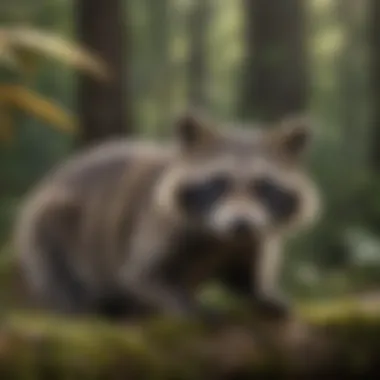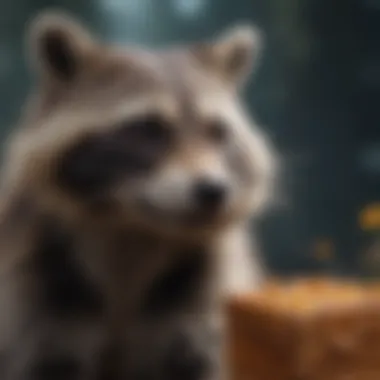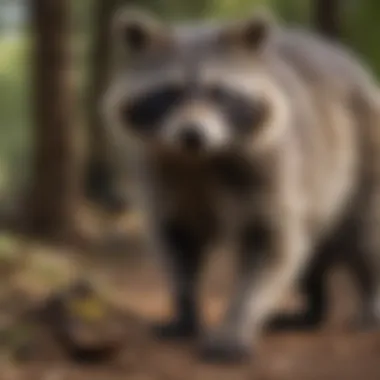Unveiling the Enigmatic World of Raccoons: Exploring Fascinating Facts


Animal Species Profile
Raccoons, often depicted as masked bandits due to their unique facial markings, are captivating creatures that thrive in various habitats across North and Central America. Known scientifically as Procyon Lotor, these raccoons display a diverse range of physical characteristics and behaviors that set them apart in the animal kingdom.
Physical Characteristics and Appearance
Raccoons are medium-sized mammals with a distinctive black 'mask' over their eyes and ringed tail. Their fur ranges from gray to reddish-brown, providing camouflage in both urban and wilderness settings. With dexterous front paws resembling human hands, raccoons exhibit impressive manual skills, aiding them in foraging and manipulating objects in their environment.
Natural Habitat and Distribution
Native to North America, raccoons are highly adaptable creatures that inhabit a variety of ecosystems, including forests, wetlands, and urban areas. Their broad distribution spans from Canada to Panama, showcasing their ability to thrive in diverse environments. Raccoons are opportunistic omnivores, feeding on a diet that includes fruits, nuts, insects, and small mammals.
Behavior and Social Interactions
Raccoons are primarily nocturnal animals, utilizing their keen senses of hearing and smell to navigate and locate food during the night. While they are often solitary creatures, raccoons can display social behaviors within family groups or during mating seasons. Their intelligence and curiosity contribute to their problem-solving abilities, allowing them to adapt to changing circumstances and environments.
Introduction
Welcome to the captivating exploration of the enigmatic world of raccoons! This article unveils a fascinating array of lesser-known facts about these intelligent creatures, offering a unique perspective on their behaviors and adaptability in the wild. As we delve into the intricate details of raccoons, you will gain an in-depth understanding of their evolutionary origins, physical characteristics, habitat preferences, and more. Through this narrative journey, we aim to paint a vivid picture of the intriguing charm that raccoons bring to the biodiversity of our planet.
In this section, we will lay the foundation for an informative and engaging study on raccoons, setting the stage for an insightful exploration of their cognitive capabilities, ecological significance, conservation concerns, and much more. By shedding light on these crucial aspects, we hope to foster a deeper appreciation for these remarkable creatures and the vital role they play in the delicate balance of nature.
Let us embark on this eye-opening journey together, as we unravel the mysteries of raccoons and uncover the hidden gems of knowledge waiting to be discovered in their fascinating world.
Understanding Raccoons
The topic of understanding raccoons is pivotal in this article as it unravels the intricate details of these intelligent creatures and sheds light on their behavior, habits, and ecological significance. By delving into the fascinating world of raccoons, readers can gain valuable insights into their evolutionary history, physical attributes, and adaptive capabilities, providing a comprehensive guide to appreciating these enigmatic beings in the wild.
Evolutionary Origins
The Procyonidae Family
When exploring the evolutionary origins of raccoons, delving into the Procyonidae family becomes essential. This family encompasses various species, including raccoons, coatis, and ringtails, sharing common ancestry and distinctive characteristics. The key characteristic of the Procyonidae family lies in their omnivorous diet and arboreal adaptations, making them versatile and adaptive creatures in diverse habitats. Understanding the evolutionary lineage of raccoons within this family provides valuable insights into their behavioral traits and survival strategies.
Adaptive Features
Examining the adaptive features of raccoons sheds light on their survival mechanisms and evolutionary advantages. Raccoons possess unique traits such as highly dexterous front paws, enabling them to manipulate objects with precision and efficiency. This manual dexterity plays a crucial role in their foraging behavior and problem-solving skills, showcasing their cognitive capabilities and adaptive intelligence. Over time, the adaptive features of raccoons have allowed them to thrive in various environments, illustrating their remarkable ability to overcome challenges and exploit resources effectively.
Physical Characteristics
Masked Faces and Ringed Tails
The distinctive physical traits of raccoons, including their masked faces and ringed tails, play a vital role in their identity and behavior. The masked facial markings serve as a visual signature, aiding in individual recognition and communication within their social groups. Additionally, the ringed tails contribute to their agility and balance, especially during climbing and navigating tree branches. These physical characteristics not only enhance the raccoon's aesthetics but also serve functional purposes in their everyday lives, reflecting their adaptability and evolutionary heritage.
Manual Dexterity
Raccoons' exceptional manual dexterity sets them apart from other wildlife species, showcasing their ability to manipulate objects with precision and finesse. Their front paws feature sensitive touch receptors and coordinated movements, allowing them to open containers, turn knobs, and extract food efficiently. This manual dexterity is crucial for their survival in diverse habitats, enabling them to access food sources and navigate complex environments with ease. By emphasizing the significance of their physical abilities, one can appreciate the evolutionary adaptations that have empowered raccoons to thrive in challenging ecosystems.
Habitat and Distribution


Diverse Range
Exploring the diverse range of habitats where raccoons thrive illustrates their adaptability and ecological flexibility. From wooded forests to urban settings, raccoons have demonstrated the capacity to inhabit diverse landscapes and coexist with human communities. Their ability to adapt to various environments highlights their resilience and resourcefulness, making them successful colonizers in both natural and human-modified ecosystems. Understanding the diverse range of raccoon habitats provides valuable insights into their behavioral plasticity and evolutionary success.
Urban Adaptation
The urban adaptation of raccoons showcases their remarkable ability to thrive in human-dominated landscapes, capitalizing on available resources and ecological niches. Raccoons exhibit behaviors such as scavenging, denning in human structures, and exploiting anthropogenic food sources, reflecting their adaptability to urban environments. This adaptation not only underscores their ecological flexibility but also poses challenges for managing human-wildlife conflicts and promoting coexistence. By exploring the intricacies of raccoons' urban adaptation, one can gain a deeper appreciation for their evolutionary resilience and behavioral plasticity.
Behavioral Insights
In this article, we delve deep into the intricate behavioral patterns of raccoons, shedding light on their social interactions, feeding habits, and nocturnal lifestyle. Understanding the behavioral insights of these intelligent creatures is essential to grasp their survival strategies and adaptability in various environments. By examining their adept problem-solving skills, we gain valuable insights into how raccoons navigate challenges in the wild.
Social Interactions
Complex Communication
Delving into the realm of complex communication among raccoons unveils a sophisticated network of signals and behaviors that contribute to their survival in the wild. The intricate vocalizations, body language, and scent markings serve as key elements in their communication, facilitating interactions within their social groups and defining hierarchies. The adaptability of raccoons in utilizing various communication methods highlights their intelligence and social cohesion, ensuring effective collaboration for shared goals.
Family Dynamics
Exploring the family dynamics of raccoons reveals the importance of kinship and cooperative behavior within their communities. The role of family units in nurturing young raccoons, teaching survival skills, and fostering bonds emphasizes the significance of social structure in their lives. The intricate interplay of roles and responsibilities within raccoon families showcases their adaptability and resilience in navigating the challenges of their dynamic environments.
Feeding Habits
Versatile Omnivores
Raccoons' status as versatile omnivores underscores their ability to thrive on a diverse diet consisting of plant matter, insects, small animals, and human leftovers. This dietary flexibility not only ensures their nutritional requirements are met but also enables them to exploit a wide range of food sources available in their habitats. The adaptability of raccoons in adjusting their feeding habits to environmental changes reflects their resourcefulness and opportunistic nature, contributing to their survival in varied ecosystems.
Foraging Techniques
The foraging techniques employed by raccoons showcase a combination of physical agility, keen senses, and problem-solving abilities. Their adeptness in raiding food caches, opening containers, and using their paws to manipulate objects demonstrates their dexterity and intelligence in obtaining sustenance. By exploring the nuances of raccoons' foraging behavior, we can appreciate the evolutionary adaptations that enable them to secure food efficiently in competitive environments.
Nocturnal Lifestyle
Adaptations for Nighttime Activity
Raccoons' nocturnal lifestyle is supported by a suite of adaptations that enhance their sensory capabilities and foraging efficiency during low-light conditions. Their keen night vision, acute sense of smell, and silent movements equip them for navigating darkness and outsmarting nocturnal predators. The specialized features that facilitate their nighttime activities highlight the evolutionary strategies that have enabled raccoons to carve a niche in the nighttime ecosystem.
Sleep Patterns
Exploring the sleep patterns of raccoons unveils the intricacies of their rest habits and the factors influencing their sleep-wake cycle. Raccoons' ability to exhibit both short naps and long periods of rest reflects their adaptability to environmental stimuli and energy conservation needs. The balance between alertness and restfulness in their sleep patterns signifies a strategic approach to maximizing survival chances while maintaining cognitive sharpness, emphasizing the importance of quality rest for their overall well-being.
Cognitive Capabilities
In the realm of raccoons, delving into their cognitive capacities unravels a world of intellectual prowess that sets them apart in the animal kingdom. Understanding their cognitive capabilities provides essential insights into their problem-solving skills, adaptive intelligence, and innovative approaches to challenges. Raccoons' mental acumen plays a pivotal role in their survival and interactions within their ecosystems, showcasing a complex and fascinating cognitive landscape that intrigues researchers and animal enthusiasts alike.
Problem-Solving Skills
Raccoons exhibit exceptional problem-solving skills, notably in tool usage and memory retention. Their adeptness in utilizing tools for various tasks highlights their resourcefulness and adaptability in navigating their environments. Observing raccoons utilize different objects to overcome obstacles or obtain food underscores their cognitive flexibility and capacity to innovate solutions. Furthermore, their impressive memory retention allows them to remember essential information such as food sources or optimal shelter locations, contributing significantly to their survival in dynamic habitats.


Tool Usage
The utilization of tools among raccoons presents a remarkable adaptation that showcases their cognitive sophistication. Raccoons demonstrate a keen understanding of object manipulation to achieve specific goals, whether for accessing food, constructing shelter, or defending themselves. Their precise handling of objects and ability to repurpose items reflect their ingenuity and problem-solving prowess, emphasizing the strategic use of tools to enhance their survival strategies. Despite some limitations in tool complexity, raccoons' proficiency in tool usage exemplifies their intelligent decision-making and adaptability to diverse challenges.
Memory Retention
Memory retention plays a fundamental role in raccoons' cognitive toolkit, enabling them to recall critical information vital for their daily activities and long-term success. Raccoons' capacity to remember significant locations, such as den sites or reliable food sources, aids in their navigation within their territories and enhances their foraging efficiency. This remarkable memory retention contributes to their adaptive capabilities, allowing them to adapt quickly to variable environmental conditions and optimize their resource utilization for sustenance and shelter.
Learning Abilities
Exploring raccoons' learning abilities unveils their adaptive intelligence and observational learning aptitudes. Their propensity for acquiring knowledge through observation and experience underpins their capacity to respond effectively to novel challenges and changing circumstances. Raccoons' learning processes reflect a blend of innate adaptability and environmental responsiveness, shaping their behavioral patterns and problem-solving approaches in dynamic settings.
Adaptive Intelligence
Raccoons' adaptive intelligence manifests in their ability to assess situations, devise strategies, and adjust their behaviors accordingly for improved outcomes. Their flexible cognitive framework enables them to respond to varying stimuli and environmental cues, showcasing their capacity for quick decision-making and behavioral modifications. This adaptive intelligence equips raccoons with the tools necessary to navigate complex ecosystems and engage successfully with diverse ecological components.
Observational Learning
Observational learning plays a pivotal role in raccoons' knowledge acquisition and skill development, allowing them to leverage social cues and environmental feedback to enhance their survival techniques. By observing conspecifics and responding to environmental stimuli, raccoons refine their foraging, social, and problem-solving skills, adapting their behavior based on successful outcomes and community interactions. This observational learning capacity strengthens raccoons' adaptive capabilities, fostering a collaborative learning environment within raccoon populations and facilitating information exchange among individuals.
Creativity and Innovation
Raccoons' creativity and innovation shine through their unique problem-solving approaches and environmental adaptability. Their unconventional strategies and adaptive behaviors underscore their capacity to think outside the box and adapt to challenging circumstances, promoting their resilience and persistence in overcoming obstacles. Raccoons' creative problem-solving methodologies exemplify their out-of-the-box thinking and dynamic response mechanisms to novel situations, enhancing their capacity for environmental engagement and resource utilization.
Unique Problem-Solving Approaches
Raccoons' unique problem-solving approaches demonstrate their creative thinking and unconventional problem-solving strategies in confronting obstacles and fulfilling their needs. Whether devising innovative ways to access food resources or overcoming human-induced challenges, raccoons exhibit a diverse array of problem-solving techniques that highlight their cognitive flexibility and inventive solutions. Their intellectual diversity and adaptive responses underscore the importance of embracing creative problem-solving in dynamic environments.
Environmental Adaptability
Environmental adaptability defines raccoons' capacity to thrive in various habitats and conditions, showcasing their resilience and resourcefulness in adapting to changing landscapes. Raccoons' ability to adjust their behaviors, diet preferences, and shelter choices according to environmental shifts exemplifies their adaptive prowess and survival instincts. Their aptitude for navigating urban environments and natural settings alike underscores their versatile nature and capacity to innovate in response to human encroachment and environmental perturbations, illustrating the dynamic interplay between raccoons and their ever-changing ecosystems.
Ecological Significance
In the realm of raccoons, their ecological significance is a topic worthy of exploration and analysis. These creatures play a pivotal role in maintaining the balance of nature and fostering biodiversity in their habitats. Raccoons are crucial agents in seed dispersal, facilitating the regeneration of forests and contributing to the sustenance of diverse plant species. By foraging for and distributing seeds, raccoons indirectly aid in forest rejuvenation and the continuity of plant life cycles. This interconnected relationship highlights the indispensable ecological function that raccoons fulfill in their ecosystems.
Seed Dispersal Role
Forest Regeneration:
Forest regeneration is a specific facet of seed dispersal carried out by raccoons, emphasizing their contribution to the rejuvenation of woodlands. Raccoons, through their foraging habits, help disperse seeds across vast areas, promoting the growth of new vegetation and enhancing forest biodiversity. Their role in seed dispersal not only aids in forest restoration but also ensures the persistence of plant species vital for ecosystem stability. The unique ability of raccoons to scatter seeds far and wide amplifies their significance in sustaining forest ecosystems.
Biodiversity Maintenance:
Biodiversity maintenance is another crucial aspect of raccoons' seed dispersal role, showcasing their impact on preserving varied plant species. By dispersing seeds of different plants throughout their habitats, raccoons contribute to the maintenance of a rich and diverse ecosystem. This active involvement in seed dispersal supports the interconnected web of life in forests, ensuring the survival of numerous plant species. The diverse range of seeds dispersed by raccoons underscores their essential role in promoting biodiversity and ecosystem resilience.
Ecosystem Impact
The effects of raccoons on ecosystems extend beyond seed dispersal, encompassing broader aspects of ecological balance and stability. Raccoons serve as keystone species, exerting significant influence on their habitats and shaping ecosystem dynamics. Their presence influences food chain dynamics and ecosystem interaction, highlighting the pivotal role they play in sustaining ecosystem health.


Keystone Species:
As a keystone species, raccoons influence ecosystem structure and function in fundamental ways. Their foraging activities, habitat preferences, and interactions with other species have ripple effects throughout the ecosystem. Raccoons' status as a keystone species underscores their essential role in maintaining biodiversity and regulating population dynamics within their habitats. Their impact reverberates across multiple trophic levels, emphasizing their significance in ecosystem stability.
Food Chain Dynamics:
Raccoons' position in food chains is integral to ecosystem functioning, dictating predator-prey relationships and energy flow within their environments. As omnivores with a diverse diet, raccoons occupy a significant niche in food webs, influencing the population dynamics of various organisms. Their feeding behavior and dietary preferences contribute to the intricate balance of ecosystem energy flow, highlighting their role in shaping food chain dynamics and overall ecosystem stability.
Urban Wildlife Management
In the urban landscape, effective wildlife management strategies are essential for fostering harmonious coexistence between humans and raccoons. Urban settings pose unique challenges for raccoons, necessitating tailored management approaches to mitigate conflicts and ensure the well-being of both wildlife and communities.
Coexistence Strategies:
Coexistence strategies play a crucial role in urban wildlife management, guiding efforts to promote peaceful interactions between humans and raccoons. Implementing measures such as secure garbage disposal, habitat preservation, and public awareness campaigns can help mitigate conflicts and foster cohabitation between raccoons and residents. By developing coexistence strategies, urban environments can sustain healthy raccoon populations while minimizing negative interactions with human populations.
Human-Wildlife Conflict Resolution:
Resolving conflicts between humans and raccoons in urban areas requires thoughtful strategies that prioritize both human safety and wildlife conservation. By addressing underlying causes of conflicts, such as food sources and habitat encroachment, effective conflict resolution can be achieved. Implementing measures like habitat restoration, wildlife deterrents, and community engagement initiatives can contribute to peaceful coexistence and sustainable management of urban raccoon populations.
Conservation Concerns
Conservation concerns are a paramount aspect of this article, shedding light on the crucial need to protect and preserve raccoon populations in their natural habitats. By addressing the various threats and challenges faced by raccoons, we can better understand the significance of conservation efforts in sustaining biodiversity. Conservation initiatives play a vital role in safeguarding raccoons against environmental disturbances and human interventions, ensuring the long-term survival of these unique creatures. Highlighting conservation concerns provides valuable insights into the delicate balance between wildlife and human activities, emphasizing the importance of coexistence and sustainable practices.
Threats to Survival
Habitat Loss
Habitat loss emerges as a primary threat to raccoon survival, primarily due to deforestation and urbanization. The destruction of natural habitats forces raccoons to adapt to rapidly changing environments, leading to conflicts with humans and other wildlife species. The diminishing availability of suitable habitats restricts the foraging and breeding capabilities of raccoons, disrupting their natural behaviors and increasing their vulnerability to various risks. Mitigating habitat loss is crucial for ensuring the continued existence of raccoons in the face of expanding human activities.
Human Encounters
Human encounters pose significant risks to raccoon populations, as interactions with humans can result in conflicts, injuries, or even fatalities for both parties. As raccoons navigate urban areas in search of food and shelter, they often come into direct contact with humans, leading to misunderstandings and negative consequences. Addressing human-raccoon interactions requires a balanced approach that considers both human needs and wildlife conservation principles, promoting harmonious coexistence while minimizing potential harm to either party.
Protection Efforts
Legal Safeguards
Implementing legal safeguards is essential for protecting raccoons from various threats, including hunting, trapping, and habitat destruction. By enacting laws and regulations that govern the conservation and management of raccoon populations, authorities can establish frameworks for preserving these animals' welfare and ecological significance. Legal safeguards not only deter illegal activities that endanger raccoons but also promote responsible behavior among the public, fostering a culture of respect and stewardship towards wildlife.
Habitat Restoration
Habitat restoration initiatives aim to recreate and rehabilitate natural environments that support raccoon populations. By reclaiming degraded habitats, restoring biodiversity, and enhancing ecological connectivity, these efforts provide raccoons with essential resources and habitats for thriving. Habitat restoration projects offer a holistic approach to conservation, tackling the root causes of habitat degradation and helping raccoons rebound from the impacts of human activities.
Community Engagement
Education Initiatives
Education initiatives play a pivotal role in raising awareness about raccoon conservation, engaging communities in learning about these animals' importance and conservation needs. By imparting knowledge about raccoons' behaviors, habitats, and ecological roles, education programs empower individuals to become advocates for raccoon protection and welfare. Educating the public about coexisting with raccoons sensitizes communities to the challenges these creatures face and fosters responsible attitudes towards wildlife stewardship.
Citizen Science Programs
Citizen science programs enlist public participation in data collection, research, and monitoring efforts related to raccoon populations and habitats. By involving citizens in scientific projects and conservation activities, these programs leverage collective efforts to gather valuable information for raccoon management and protection. Citizen science initiatives promote public engagement in wildlife conservation, fostering a sense of ownership and responsibility towards safeguarding raccoons and their habitats.
Conclusion
In the expansive realm of raccoon studies, the odyssey through intricate features ends but leaves a resonant essence. Descending from evolution to cognition and ecological roles in the wild, unveiling layers of their societal intricacies has been akin to unraveling a captivating novel. At this concluding juncture of our expedition, we emphasize the indispensable significance of understanding raccoons beyond their physical attributes. Through this article, we have deciphered the symbiotic threads they weave within ecosystems, from life trees in forests to trash bins in urban landscapes. As we peel back the layers of raccoon behaviors and adaptations, embracing the nuanced dynamics of their existence becomes imperative for conservation efforts and cohabitation with native wildlife. This culmination underscores the interwoven tapestry of humanity and raccoon domains, echoing the profound impact of appreciating wildlife beyond mere observation.







